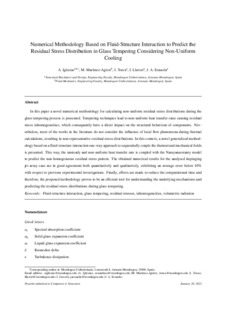| dc.contributor.author | Iglesias, Asier | |
| dc.contributor.author | Martinez Agirre, Manex | |
| dc.contributor.author | Torca, Ireneo | |
| dc.contributor.author | Llavori, Inigo | |
| dc.contributor.author | Esnaola, Jon Ander | |
| dc.date.accessioned | 2022-06-08T12:29:29Z | |
| dc.date.available | 2022-06-08T12:29:29Z | |
| dc.date.issued | 2022 | |
| dc.identifier.issn | 0045-7949 | en |
| dc.identifier.other | https://katalogoa.mondragon.edu/janium-bin/janium_login_opac.pl?find&ficha_no=167291 | en |
| dc.identifier.uri | https://hdl.handle.net/20.500.11984/5593 | |
| dc.description.abstract | In this paper a novel numerical methodology for calculating non-uniform residual stress distributions during the glass tempering process is presented. Tempering techniques lead to non-uniform heat transfer rates causing residual stress inhomogeneities, which consequently have a direct impact on the structural behaviour of components. Nevertheless, most works in the literature do not consider the influence of local flow phenomena during thermal calculations, resulting in non-representative residual stress distributions. In this context, a novel generalised methodology based on a fluid–structure interaction one-way approach to sequentially couple the thermal and mechanical fields is presented. In this way, the unsteady and non-uniform heat transfer rate is coupled with the Narayanaswamy model to predict the non-homogeneous residual stress pattern. The obtained numerical results for the analysed impinging jet array case are in good agreement both quantitatively and qualitatively, exhibiting an average error below 10% with respect to previous experimental investigations. Finally, efforts are made to reduce the computational time. Therefore, the proposed methodology proves to be an efficient tool for understanding the underlying mechanisms and predicting the residual stress distributions during glass tempering. | en |
| dc.description.sponsorship | Gobierno Vasco-Eusko Jaurlaritza | es |
| dc.language.iso | eng | en |
| dc.publisher | Elsevier | en |
| dc.rights | © 2022 Elsevier Ltd. All rights reserved | en |
| dc.subject | fluid-structure interaction | en |
| dc.subject | Glass tempering | en |
| dc.subject | Residual stresses | en |
| dc.subject | Inhomogeneities | en |
| dc.subject | Volumetric radiation | en |
| dc.title | Numerical methodology based on fluid-structure interaction to predict the residual stress distribution in glass tempering considering non-uniform cooling | en |
| dcterms.accessRights | http://purl.org/coar/access_right/c_f1cf | en |
| dcterms.source | Computers & Structures | en |
| local.contributor.group | Diseño y mecánica estructural | es |
| local.contributor.group | Mecánica de fluidos | es |
| local.description.peerreviewed | true | en |
| local.identifier.doi | https://doi.org/10.1016/j.compstruc.2022.106757 | en |
| local.relation.projectID | info:eu-repo/grantAgreement/GV/Elkartek 2021/KK-2021-00022/CAPV/Metodología de modelización multi-escala proceso-microestructura-propiedades-desempeño para la agilización del diseño de materiales, procesos y componentes metálicos en la industria vasca/ICME | en |
| local.relation.projectID | info:eu-repo/grantAgreement/GV/Ikertalde Convocatoria 2019-2021/IT1316-19/CAPV/Diseño y Mecánica Estructural | en |
| local.relation.projectID | info:eu-repo/grantAgreement/GV/Ikertalde Convocatoria 2022-2025/IT1505-22/CAPV/Mecánica de fluidos | en |
| local.embargo.enddate | 2024-05-31 | |
| local.source.details | Vol. 264. Pp. 106757, | en |
| oaire.format.mimetype | application/pdf | |
| oaire.file | $DSPACE\assetstore | |
| oaire.resourceType | http://purl.org/coar/resource_type/c_6501 | en |
| oaire.version | http://purl.org/coar/version/c_ab4af688f83e57aa | en |







